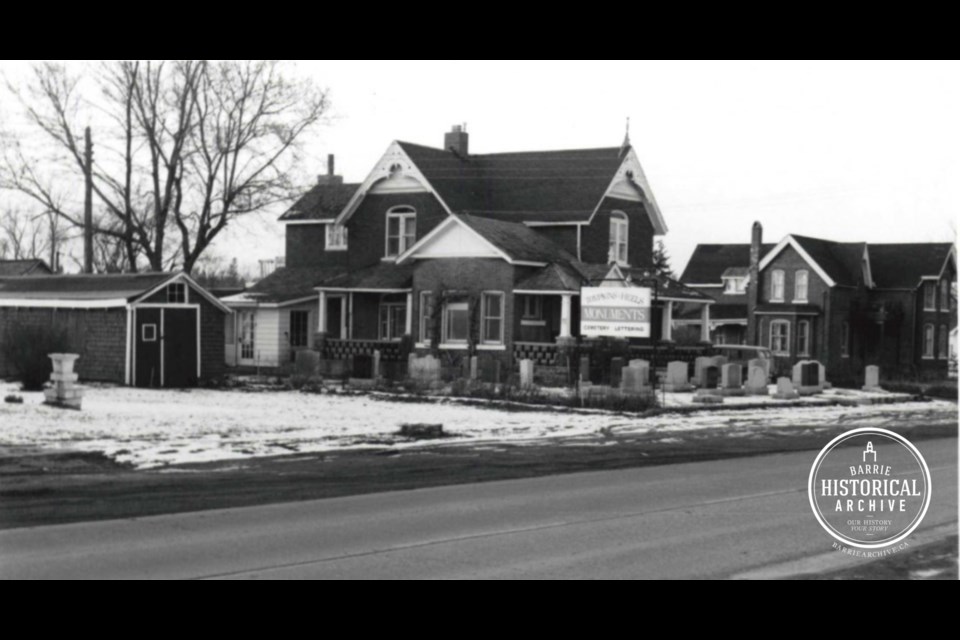This ongoing series from Barrie Historical Archive curator Deb Exel shows old photos from the collection and one from the present day, as well as the story behind them
Tompkins and Heels Monuments
The unassuming brick house at 161 Essa Rd. features the most unexpected collection of "lawn ornaments." Not to be mistaken for a tiny cemetery, it’s more like an outdoor showroom for a memorial company that has been in business for more than 90 years.
According to lore, early grave markers, formed from wood or piles of rock, were placed on graves to "keep the dead from rising." In times before cemeteries, people were buried near their homes, in simply marked plots. Eventually church graveyards would replace personal burial grounds, and larger, inscribed markers would be placed on graves.
As pubic cemeteries emerged, better materials and more sophisticated markers evolved as well. Slate was replaced by sandstone, marble (especially white marble, for royalty or the well-to-do) and limestone, whose inscriptions did not survive the weather well. But it was granite, one of the hardest materials on the planet, that became the stone of choice for gravestones, such as the ones displayed on the side yard at Tompkins and Heels Monuments in old Allandale.
Situated near the former fairgrounds on Essa Road, the gracious house was the home of Charles and Amelia Augusta (Gaus) Tompkins and their three children: George, Ruby and Alf.
Like so many Allandale residents, Charles was employed by the Canadian National Railway. Thompkins worked as an fireman when he first relocated to the area from Listowel, eventually becoming an engineer. Charles built a new home at 164 Essa Rd., and moved there with Amelia. The house at 161 Essa Rd., was divided into two apartments.
Barbara (Aryest) Miscampbell, who was the neighbour to 161 Essa Rd., recalls downed power lines in front of their homes and Mr. Tompkins trying to help guide traffic around the hazard when he was tragically electrocuted. His funeral was held at 161 Essa Rd.
The Tompkins kids all attended King Edward Public School, Barrie Collegiate Institute and Burton Avenue United Church.
Following high school, George apprenticed in the stone industry with the Ritchie Cut Stone Company in New Toronto. Ritchie's provided stone for many fine buildings including the Stoney Creek Battlefield Monument Memorial to the Heroes of the War of 1812, the new 1927 wing of the Château Laurier in Ottawa, the entrance pilon to Sunnybrook Hospital, several iconic Toronto office buildings such as the entrance to the Canadian Bank of Commerce, Bank of Montreal, Globe and Mail and the Canada Life Assurance Company head office.
The Douglas Library at Queen’s University in Kingston, Ontario College of Pharmacy in Toronto, the Victoria Residences at the University of Toronto and the St. Andrew and St. Paul Presbyterian Church in Montreal are just a few more of the many, many impressive Ritchie stonework projects across Ontario, Quebec and the Maritimes.
Following his apprenticeship, George opened Tompkins Monuments at his home at 161 Essa Rd., in 1932. George married Dorothea (Dorothy) King, daughter of beekeeper Robert King and his wife, Violet, who lived farther out the Essa Road at Chula Vista. Tompkins was an avid hunter, fisherman and a member of several lodges. He was joined in the monument business by younger brother Alf, to form Tompkins Brothers monuments.
Not long after Tompkins started his monument company, the directors of the Barrie Union Cemetery were considering a monument project of their own: the Barrie Memorial Mausoleum.
The proposed cut stone, marble and bronze structure would be built on a site within the cemetery and offer an alternative to ‘distressing’ ground burials, a place where loved ones could rest side by side in compartments high and dry above ground in a monumental building. Community interest, pre-sales and the board’s assessment must not have proved the project to be worthwhile as there are only small, private mausoleums in the cemetery today.
The lovely brick home at 161 Essa Rd. wasn’t always a place of sadness and sombre business. In 1928, the Tompkins’ daughter, Ruby, was married at the family home. Dressed in a period gown of white crepe trimmed with real lace, a veil caught up with lily-of-the-valley and carrying a bouquet of butterfly roses, lily-of-the-valley and baby’s breath, Ruby married her sweetheart, Ted.
After the reception at home, the couple took the evening train to Niagara Falls and Atlantic City. They would reside in Toronto, and later Orillia. The groom was Arthur Edwards Heels, son of Harry and Christina Heels of 223 Bradford St.
Ruby and Ed’s son, Ted, started work in the monument business after high school, where George taught him the skills of a stone mason. When George Tompkins died after a lengthy illness, Ted joined Alf as partner in the family business and so we have Tompkins and Heels Monuments Inc.
George, Alf, Ted: monument men.



